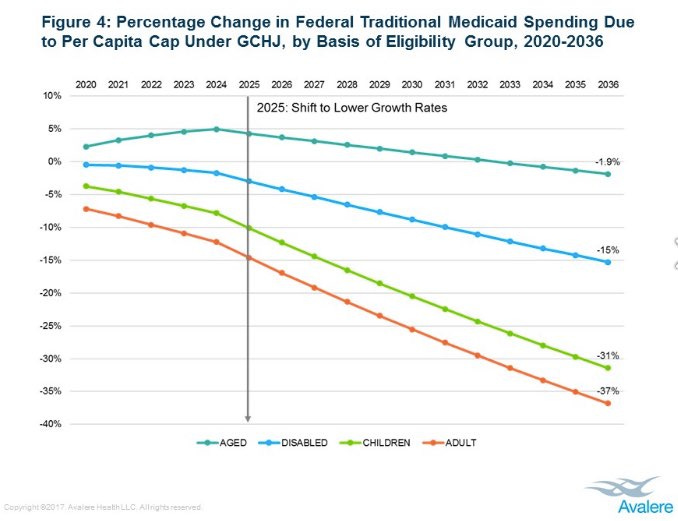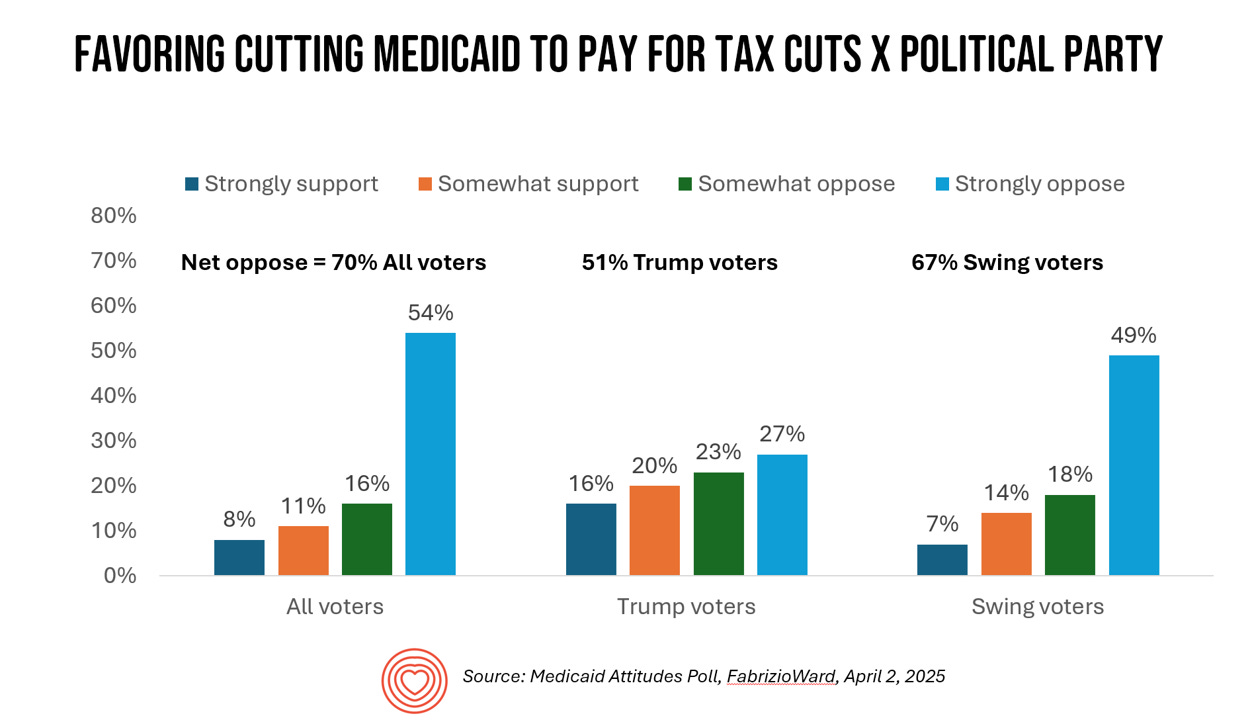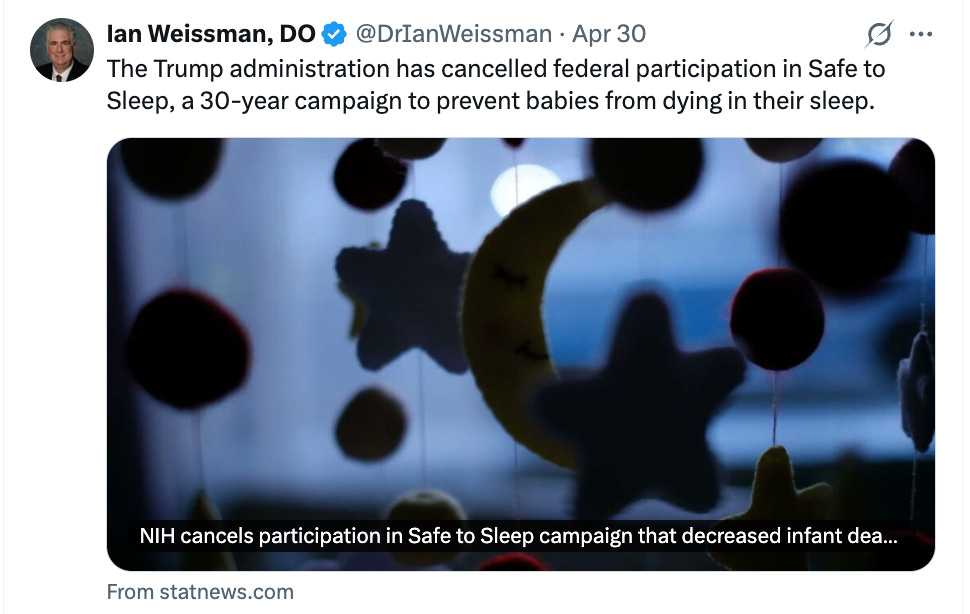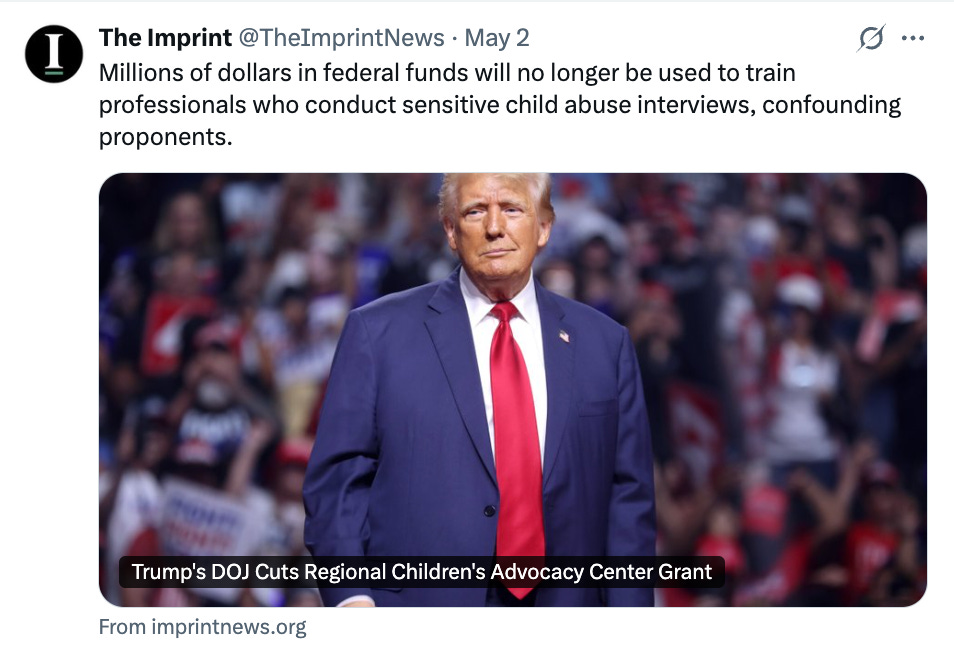In American politics, the first 100 days of a presidency are more than just a benchmark — they’re a blueprint. They show us what a president values, who they prioritize, and how they intend to wield power.
In the case of Donald Trump’s first term, those first 100 days sent a chilling message: when it came to the needs of children, they would be put last. Now, with Trump 2.0 past its 100-day mark, we must reckon with the choices made in its opening days – not just as a matter of history, but as a warning for the future.
The proposed budgets, the programs targeted, and the values revealed did not represent a departure from the past. We saw much of this in the first term – just less organized and focused.
What we are witnessing now is a doubling down on the most troubling aspects of the first Trump Administration, in which children’s programs were disproportionately targeted for cuts and kids were treated as an afterthought in budget and policy priorities.
Budgets reflect values. And the values made plain in Trump’s first term, and now in the first 100 days, are both intentional and deeply instructive.
The Many Challenges Facing Children
Our nation’s children and grandchildren are not doing well. By any objective indicator, our children are struggling:
Rising Infant and Maternal Mortality
Rising Child Mortality
Rise in Gun Violence (homicides, suicides)
Child Poverty Doubled: 5.2% in 2021 to 13.7% in 2023
Increasing Rates of Uninsured Children
Children’s Mental Health Crisis
Increasing Rates of Child Hunger
Vaccine Rates Declining: outbreaks of measles, the flu and pertussis are all on the rise
Children are facing a crisis on many fronts. And yet, the Trump Administration’s response has been disturbing.
While some in the movement have called for “pronatalism,” the actual policies have targeted children with funding cuts and deliberate harm.
Attack #1: Eroding and Threatening Child Health
Health care is foundational to a child’s ability to grow, learn, and thrive. It’s not a luxury — it’s a fundamental need and right that determines whether a child survives birth and the first year of life, gets the screenings that catch vision loss before it impacts reading, the treatment for asthma that prevents emergency room visits, or the vaccinations that shield them from deadly disease.
But in its first 100 days, the Trump Administration launched an agenda that treated children’s health not as a national priority, but as a political target – part of a culture war and a budget line item to slash for tax breaks for the wealthy.
While both parties have shielded Medicare from attacks, the Trump Administration has put at the helm of the Office of Management and Budget (OMB) Russ Vought who, while serving as president at the Center for Renewing America, proposed well more than a trillion in cuts to Medicaid and the Children’s Health Insurance Program (CHIP). It reads:
The proposal would allow states to refocus their efforts on the most vulnerable populations — including the aged, blind, and disabled — for whom Medicaid was originally designed to assist.
Which group is NOT identified in Vought’s list of protected populations? CHILDREN.
In Trump’s first term, efforts to abolish the Affordable Care Act (ACA) were paired with an arbitrary cap on Medicaid funding, which would have rationed care for senior citizens, people with disabilities, children, and low-income adults.
Children with complex medical needs — like those born with congenital heart defects or living with chronic illness — would have been among the first casualties. The fiscal caps would have incentivized severe rationing of care for these kids, including children with cancer.
House Republicans made clear children were an afterthought when they tweeted in June 2017 that “Medicaid’s priorities ought to be the elderly and the disabled.”
This tweet was a harbinger of things to come because children were increasingly targeted for the heaviest of cuts as the bill moved through Congress.
Eight years later, proposed Medicaid, Children’s Health Insurance Program (CHIP), and ACA cuts are back. This year’s congressional budget resolution includes proposals to slash up to $880 billion from Medicaid and CHIP.
These cuts would threaten the health coverage and care of more than 37 million children, despite that fact that research shows that children with consistent access to Medicaid and CHIP have better health outcomes, higher educational attainment, higher future earnings, and longer life expectancy.[1]
Slashing Medicaid and CHIP are not just short-term cuts — they are a long-term blow to the present and future health of children and our future.
Moreover, cutting Medicaid and CHIP is opposed by wide margins of American voters. According to a poll by FabrizioWard, the president’s own pollsters, respondents:
Oppose cutting CHIP by a 71-18% margin
Oppose cutting Medicaid by a 70-22% margin
Bob Ward, one of the pollsters, points out:
There’s really not a political appetite out there to go after Medicaid to pay for tax cuts.
Yet, the House Energy and Commerce Committee is moving forward on drafting legislation that would slash hundreds of billions of dollars from Medicaid to partially offset tax breaks that would go disproportionately to the wealthy in the package.
Compounding the harm to children, Trump and Department of Health and Human Services (HHS) Secretary Robert F. Kennedy Jr. have promoted vaccine misinformation, even as measles, flu, and pertussis (or whooping cough) outbreaks rise and threaten the lives of children.
Meanwhile, the Trump Administration has slashing agency staff and funding for the Maternal and Child Health Bureau (MCHB), the Centers for Disease Control and Prevention (CDC), the Substance Abuse and Mental Health Services Administration (SAMSHA), the National Institute for Child Health and Development (NICHD), and the Environmental Protection Agency (EPA) gutting support for such things as:
Pediatric cancer research
Environmental health
Infectious disease prevention
Health promotion
Lead abatement
Children’s mental health (including cutting the suicide hotline for LGBTQ youth)
Maternal and child health
Emergency preparedness
Rural health outreach
These are, obviously, not abstract concerns. Weakening this infrastructure means more children exposed, more preventable suffering, and more lives lost.
Despite its rhetoric, the Administration’s approach to children’s health has been both comprehensive and deliberate – a betrayal of the very idea that society should protect its youngest members from harm.
In doing so, it revealed a governing philosophy that viewed kids as a political weapon at worst and an afterthought at best, rather than as a national treasure that deserves affirmative care and protection.
Attack #2: Undermining Education and Early Childhood
Every child deserves access to a quality education — it’s one of the most basic promises a society can make to its youngest members. But during the first 100 days, the Administration signaled a retreat from providing support for the education and development of America’s children and our future. The proposed budget and associated policies amounted to a disinvestment in public education, particularly for children who are most in need of support.
Early in the Administration, President Trump signed an Executive Order calling for the closure of the U.S. Department of Education. Far from symbolic, this proposal had real and dangerous implications.
The Department of Education is not just the only Cabinet-level department focused on children; it is the engine that drives federal funding to public schools, ensures equity under civil rights laws, and administers support for nearly 26 million low-income students and more than 7.5 million students with disabilities. The Department also provides early childhood education and child care funding to young children all across the country.
Eliminating the Department would effectively sever the federal government’s commitment to educational opportunity. States, school districts, early childhood, and child care programs already vary dramatically in funding levels and resources. The Department’s role is to ensure a baseline of fairness — making sure a child in rural Mississippi or inner-city Detroit gets a chance to succeed like a child in a wealthier suburb. Pulling out that foundation would widen disparities based on zip code, race, and income.
This idea isn’t just idle talk. The Project 2025 blueprint, crafted by former Trump officials and conservative think tanks, spelled out a detailed plan to dismantle the Department and devolve authority without guarantees of equity or access. In the name of “local control,” the plan intends to abandon vulnerable students.
These budget choices also reflect a broader agenda to devalue public education and redirect resources toward private and charter alternatives — without oversight or equity. The Trump Administration champions school voucher programs and “school choice,” while downplaying the government’s role in protecting students’ civil rights. For children with disabilities, English language learners, and students facing housing instability, this approach is tantamount to abandonment of long-standing education protections.
At its core, education is not just about test scores or curriculum. It’s about opportunity, inclusion, and dignity. The Trump Administration’s first 100 days told a clear story: those values were negotiable and expendable when it came to children.
Rather than valuing fairness and the diversity, accessibility, inclusion, and equity of students, we are seeing an Administration that is engaged in promoting division, inequity, exclusion, uniformity, and segregation.
Funding for early childhood and child care programs is also under assault. Project 2025, for example, proposed the complete elimination of Head Start, the nation’s flagship early childhood program for low-income families. Serving more than 750,000 children, Head Start isn’t just a classroom — it provides children with critical school readiness, meals, medical screenings, and a safe space to learn and grow.
These policies aren’t just a policy shift; they reflect an attack on the very idea that every child deserves a fair start. Research consistently shows that children who attend high-quality preschool programs are more likely to succeed academically, graduate high school, and avoid involvement with the criminal justice system. By proposing to eliminate Head Start and the gutting of early childhood programs, the administration is signaling that these outcomes — and the children behind them — are not worth investing in.
Attack #3: Hollowing Out the Social Safety Net and Legal Protections for Children
Even in the best of times, millions of children in the U.S. depend on a patchwork of legal protections and social services to ensure they’re safe, supported, and given a fair chance. For children living in poverty, facing abuse, or entangled in custody disputes, these protections can be the difference between stability and crisis. And yet, in its first 100 days, the Trump Administration proposed budget cuts that would hollow out these systems, leaving children more vulnerable to harm, exploitation, and abandonment.
The Trump Administration and Congress are, for example, targeted programs that meet children’s most basic needs: food and safety. Cuts to the Supplemental Nutrition Assistance Program (SNAP), school meal programs, and the Women, Infants, and Children (WIC) program will leave millions of children hungrier and less healthy. One in six children in the United States lives in a food-insecure household. These services are essential, not optional.
These cuts are compounded by the array of cuts being implemented and proposed to programs in the Administration for Children and Families (ACF).
In just 100 days, the Trump Administration has threatened numerous programs and children.
These cuts also threaten the safety of children, including programs that support investigations into child abuse and child exploitation, including trafficking and online abuse.
Children rely on adults not just for care and guidance, but for protection from forces beyond their control: poverty, abuse, exploitation. The Trump Administration’s proposed budget in its first 100 days stripped back those protections – not because it had to, but because it choses to.
As a nation, we don’t measure the strength of a nation by how it treats the powerful. We measure it by how it protects the most vulnerable. And in its first 100 days, the Trump Administration failed that test.
We Must Demand a Better Future for Our Children in This Administration and Beyond
The first 100 days of any presidency set the tone for what’s to come. They reveal not just preferences, but they reveal purpose and values. And in the opening days of the Trump Administration, the purpose revealed is deeply alarming.
Children were not centered. They were not protected. They were ignored – or worse, directly harmed and battered.
During the President’s first day in office, for example, he issued an Executive Order threatening birthright citizenship, which targets babies for statelessness, exploitation, and harm.
We cannot build a strong nation while weakening its youngest generation. And we cannot talk about “family values”, “pro-life”, and “pronatalism” while dismantling every system that helps families and children survive. There are real lives behind the budgetary line items.
Children don’t vote. They don’t hire lobbyists. They don’t make campaign contributions. That is why they need us.
The child advocacy community must meet this threat. The true meaning of bipartisanship demands that we speak on their behalf and call upon any Administration or Congress, no matter the party in control, to be held accountable for its treatment of children.
We must insist that budgets center children. We must push back against policies that treat kids as expendable. And we must recognize that investing in children is not charity — it’s nation-building and benefits all of us.
The next 100 days — and every 100 days that follow — must look different. They must begin with a simple principle: every child counts and every child matters.
What You Can Do
📞 Call your Members of Congress: Demand they reject budget cuts to Medicaid, CHIP, SNAP, Head Start, and other critically important children’s programs.
🗳️ Make children a voting issue: Ask politicians where they stand. Hold them accountable: whose for kids, and whose just kidding?
💵 Support child advocacy organizations: Donate or serve as an Ambassador for groups like First Focus on Children or other national, state, or local child advocacy organizations.
📣 Spread the word: Share this post. Start conversations. Help bring children out of the shadows of policy debates and back into the center of policy decisions.
ENDNOTE
[1] Brown, D. W., Kowalski, A. E., & Lurie, I. Z. (2015, Jan.). Medicaid as an investment in children: what is the long-term impact on tax receipts? National Bureau of Economic Research, Working Paper 20835; Cohodes, S. R., Grossman, D., Kleiner, S., & Lovenheim, M. F. (2016). The effect of child health insurance access on schooling: Evidence from public insurance expansions. Journal of Human Resources, 51(3), 727-759; Goodman-Bacon, A. (2018). Public insurance and mortality: evidence from Medicaid implementation. Journal of Political Economy, 126(1), 216-262; Hoynes, H. W., & Schanzenbach, D. W. (2018, May). Safety net investments in children. National Bureau of Economic Research, Working Paper 24594; Miller, S., & Wherry, L. R. (2019). The long-term effect of early life Medicaid coverage. Journal of Human Resources, 54(3), 785-824; Thompson, O. (2017). The long-term health impacts of Medicaid and CHIP. Journal of Health Economics, 51, 26-40.
















